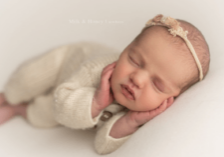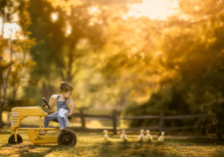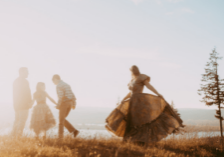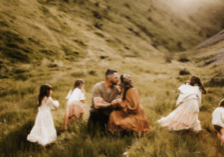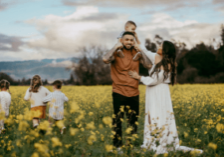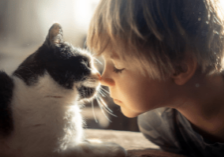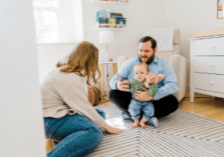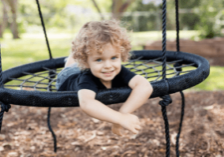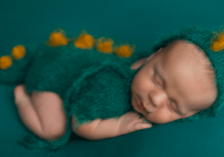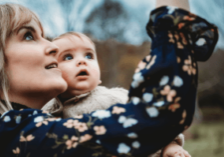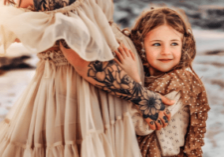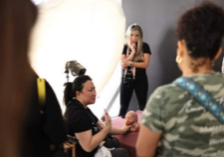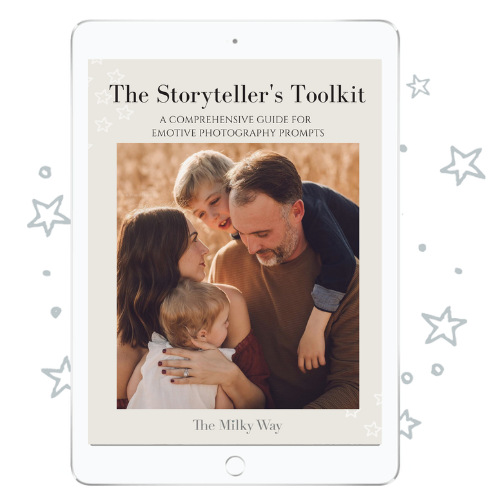Focus on Inclusion: Empathy and Advocacy in Neurodivergent Family Photography with Stacey Feasel
When you’re a photographer, you learn that no session is quite the same as the last! That’s especially true when working with children and, in particular, photographing neurodivergent children. So what can you do during those sessions to ensure your studio is a safe and inclusive environment for everyone? This guest has the answer!
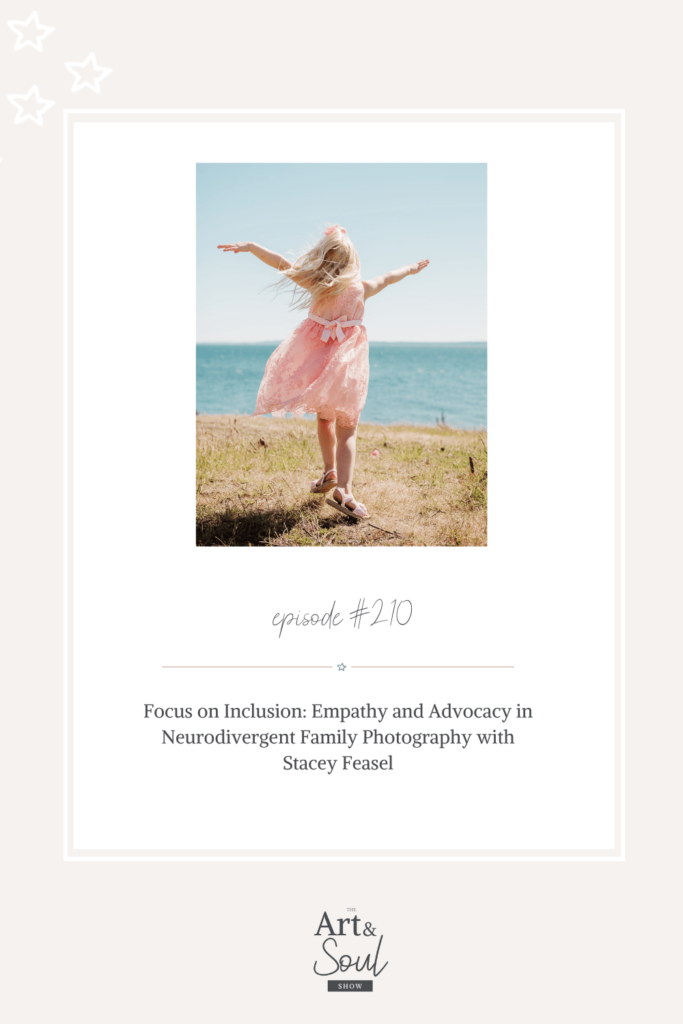
In today’s episode, I’m interviewing Stacey Feasel, a professional family photographer and parent of a neurodivergent child herself. You’ll hear how her own experience has influenced her approach to photography, why it’s so important to be flexible and attuned to different needs, and her best advice on creating a seamless and memorable experience for every family. Want to feel more confident photographing neurodivergent children? Listen in now!
So, get cozy, grab your notebooks, and tune in. I’m rooting for you, my friends.
What’s in this episode:
- [02:08] How being the parent of a neurodivergent child has influenced Stacey’s career
- [07:20] How Stacey advocates for the neurodivergent community in her sessions
- [14:36] How Stacey communicates her “why” message through photography
- [18:07] How to work with neurodivergent children that are higher needs
- [20:01] Important location scouting tips and special considerations
- [26:11] Asking the right questions and creating seamless sessions
- [31:14] Establishing an inclusive environment in your studio
Tune in to this episode to learn how to accommodate neurodivergent children in your photography sessions.
SUBSCRIBE: Apple Podcasts | Spotify
Resources Mentioned
Neurodivergent Photography Education
Meet Stacey Feasel
Stacey is a mom of a neurodivergent ten-year-old and, so far, a neurotypical six-year-old. She has her hands full! She’s been running her own photography business with compassion and a zest for learning for six years. Her experiences in navigating how to best serve her daughter throughout her life’s journey has brought her to the place of advocating for the neurodivergent community. Life for neurodivergent families is a complicated and delicate balance, and she knows this firsthand and has worked hard to create a safe space for these families in front of her camera lens.
Connect with Stacey
Did this episode provide you with a roadmap for photographing neurodivergent children? Check out this episode Everyone Deserves To Have Their Story Told – Photographing Children with Special Needs with Iris Hu which shares how another photographer started their career!
Transcript
[00:00:01] Stacey Feasel: So pretend that I’m a babysitter. And this is the very first time that you’re leaving your kids with me. What would you tell me about them? What would. What triggers them? What comforts them? What? What should I know? If you were leaving your kids with me for the first time. And I get some great answers, and it clues me into whether I may have someone that might be neurodivergent there. [00:00:25][23.5]
[00:00:29] Lisa DiGeso: Welcome to the Art and Soul Show, where we dive into heart opening chats on photography, business, life and that messy in-between. I’m your host, Lisa DiGeso, a mom, a photographer and entrepreneur, and I’ll be sharing honest conversations and advice for photographers with insight on mindset, entrepreneurship, and creativity. The goal of this podcast is for you to be able to gain insights and strategies that will get you real results. Because let’s face it, having a photography business can be lonely, but it doesn’t have to be. This is the place you can go when you need a boost of encouragement, a kick in the pants, and inspiration to pick up your camera. This is the Art and Soul Show. [00:01:11][42.3]
[00:01:12] Lisa DiGeso: Hello my beautiful friends. Welcome back to the show today I’m super excited to dive into today’s conversation with Stacey Feasel. Stacey is a mom of a neurodivergent ten year old, and so far in neurotypical six year old, she has her hands full. She’s been running her own photography business with compassion and a zest for learning for six years. Her experiences and navigating how to best serve her daughter throughout her life’s journey has brought her to the place of advocating for the neurodivergent community. Like her, new her and her family’s is complicated and a delicate balance, and she knows this firsthand and has worked hard to create a safe space for these families in front of her camera lens. She’s so excited to share what she has learned through the years. After talking to professionals about how, as photographers, we can better serve the neurodivergent community. Welcome, Stacey. [00:02:02][50.3]
[00:02:04] Stacey Feasel: Thank you so much, Lisa. I am so excited to be here. Thanks for having me. [00:02:07][3.4]
[00:02:08] Lisa DiGeso: I’m so excited to dive into this conversation. It’s interesting because I actually had coffee with a friend, from high school, and we kind of just have a tight knit. We’ve been playing tag for 20 years, and she’s the mother of a son with autism. And so we were really talking about she’s also a photographer. Yes. So so I was like, this is so great because I’m going into this conversation with Stacey next week and I have so many questions. So, can you share maybe a little bit about your personal journey as a mother of a neurodivergent child and how it has influenced your approach to family and newborn photography? [00:02:42][34.0]
[00:02:44] Stacey Feasel: I would love to. Yeah. So my daughter, Tessa and I did. I did speak with her. I talked to Tess. Then I got permission to share her diagnosis and honor that she is okay with me talking about that. And so let me. Yeah, share some of my journey. It has is just an amazing kid first and foremost. And that’s so great. Like, she was ahead of the curve. And we’re all, like, proud as parents. Like she was walking and talking before nine months. So yeah. Right. So on the move and on the go. And then we kind of realized that the side that comes with that is that, she also has a lot of sensitivities. So we realized that she would get super overstimulated and loud environments, had a really hard time sleeping. Clothing was really challenging. And we started really seeking help when she was in kindergarten because kindergarten was was a challenge. And then got her diagnosed. So her diagnosis is, I call it our alphabet soup because there’s all these letters that just float around. Right. So she’s got ADHD and she’s got the, combined version, which means she’s both hyperactive and attentive. Which, you know, it’s kind of fun. She just checks out like, oh, okay. She is autistic, so she’s high functioning. She’s very smart, has an incredible memory for everything, which is only sort of annoying because she’ll remember everything you said. Everything and everything. Right? You say maybe I know it was. There was. There was no qualifier there. Yeah. She’s also so in the sensory processing challenges. Sensory processing disorder isn’t technically like a diagnosis, but that definitely comes into play. And there’s reflexes that didn’t get integrated. So she skipped crawling and she went right to walking. And so she has balance issues that we had to work through with occupational therapy and stuff. And so definitely a big journey, you know. And then all of that just adds anxiety. So she’s got anxiety as well. And all of that. I started my career full time when my second daughter was born because I couldn’t afford two kids in daycare, and I have a photography and painting degree, so I’m just going to go for it was what I decided, and I just structured my sessions the way that would work for my daughter. For Tessa. I didn’t even know what golden hour was when I started. Yeah, I just did all my sessions in the morning because that’s when Tessa did the best, and I started working with all these families that had so much energy, and I just played with them. And yeah, I ended up really growing my business with referrals because I had such compassion and people felt comfortable with me. So it was it was a beautiful way to start, and I didn’t really realize until about a year ago that what I do at my sessions is different than other. Photographer since. Still, I plugged into a Seattle photography group here and I was like, oh, you don’t do that. Oh, you don’t like oh. And so, it’s really developed, a wonderful business for me. And what I’ve found is I encounter neurodivergent people in every aspect of photography, whether I’m doing headshots or weddings or newborns especially. So all my newborn sessions I do in home, and I even do the post studio style in home, which. It allows for those like high energy kids. They can be there for the family portion and then go check out and instead of having them hang on the the sessions. So it’s yeah, it’s really led to a lot of fun success and meeting great people. [00:06:11][207.2]
[00:06:11] Lisa DiGeso: Yeah, I love that. What I find fascinating too is, you know, back because we were talking before we were on camera, we’re both in our 40s, that I sometimes wonder if I probably should have had an ADHD diagnosis as a child, because a lot of the things that I’m seeing and things that I think for myself, or maybe I have, turn them into superpowers, but I sometimes wonder if those would have been, at the time, diagnosis for neurodivergent. The symptoms [00:06:40][28.1]
[00:06:41] Stacey Feasel: Absolutely. I totally think that if I were to seek a diagnosis, I would have ADHD too. But yeah. They there’s so many wonderful side like, not side effects, but things that go along with these diagnosis. They’re really good at problem solving or so creative. I would actually challenge. Most of us photographers are probably neurodivergent in some way, shape or form. [00:07:01][19.8]
[00:07:02] Lisa DiGeso: Or like the I focus on like hyper focus or like no focus at all. It’s like it’s just that. [00:07:07][5.3]
[00:07:08] Stacey Feasel: Yeah, yeah. Like we were. I have a shirt that says, I have so many tabs open, I don’t know where the music’s coming from. Like, I don’t know. It’s like so, so, true. [00:07:19][10.8]
[00:07:20] Lisa DiGeso: Know, advocating for the neurodivergent community really seems like a significant passion for you. And I love this so much. So how has this advocacy translated into the way you structure and approach your own family sessions? [00:07:31][11.9]
[00:07:32] Stacey Feasel: Yeah. So it’s going to be a really rare parent that actually shares with you that their child is neurodivergent before the session. And that’s that’s just because they don’t know you. You’re a photographer. You’re going to be in their life for an hour or maybe three if you’re doing a newborn session. And so they they don’t always open up. And a lot of it becomes me advocating for what the kid is comfortable with at the session. So I mentioned that Tessa had balance issues earlier. And you’ll kind of see that in sessions when you like, oh, throw the kid on your shoulders. Right. And if the kid really panics, then I can tell that there’s probably something going on. And so it’s really being like, hey, nope, they’re uncomfortable with that and let’s take them down. That’s not a pose that we’re going to do this time. Yeah, a lot of it really becomes at the session about making sure that the kid feels really comfortable. And I do that for every session doesn’t necessarily have to be one that is specifically neurodivergent. [00:08:30][57.4]
[00:08:31] Lisa DiGeso: So yeah, 100%. One thing I’ve noticed in my own sessions has been children with specifically with outfits and, and clothing that they feel comfortable or they feel safe with. Yeah. And just really not pushing like even though as photographers, we get this idea in our head, everybody wants to have these picture perfect stylized sessions. And sometimes it’s hard because you interact with a child who just you can tell they do not feel safe or comfortable in what they’re wearing or what they’re being forced to wear for the session. [00:09:02][31.8]
[00:09:03] Stacey Feasel: Absolutely. [00:09:03][0.0]
[00:09:04] Lisa DiGeso: And so, like, do you step in at that time when you see someone who is, you know, wanting or forcing their child to be wearing something and you can tell that the the child just doesn’t want to. [00:09:13][9.1]
[00:09:15] Stacey Feasel: So I don’t tend to style my shoots, but in that, in that way, if they’re trying to force them to do something, then yeah, I do step in. I actually have a blog about dressing for a neurodivergent child. So when I do my precession stuff, I send out, I have one for like I send out post links on hey, here’s how to dress your family. And if you think you know, here’s this one too. I’m not judging, and they can read over the How to dress for a neurodivergent and it talks about get their, clothing like a month before the session and let the child pick it, let them try it on like really work with them. My my daughters won’t won’t wear anything cute and flowy and it’s, you know, it’s just is what it is. But yeah, you have to really respect that those clothing it’s and it what it does is when it’ll set off a nervous system fight or flight. Yeah. Thing in their body. So it’s not just like oh they’re uncomfortable. It actually is triggering them that there’s danger. And that is if you lose the kid at the session, man, it’s just all over. [00:10:19][64.1]
[00:10:20] Lisa DiGeso: But yeah. Yeah. Now I’m assuming bribery is probably not going to be as useful as maybe it is with. Non neurodivergent children. [00:10:29][9.3]
[00:10:30] Stacey Feasel: Oh my gosh, I’m so glad that you brought that up. It is because a lot of these kids have a lot of anxiety. It’s just a byproduct. Like they they feel that they don’t fit in the world and they’re trying their best, but it really creates this, like, anxious heart in them. Yeah. So I actually really recommend that parents, you know, because parents are like, oh, if you’re good, we’re going to go get ice cream afterwards. Right. And I make it part of my precession communication that, hey, don’t don’t do that. Don’t make it conditional because it increases their anxiety. It’s just saying, no matter what, we’re going to have a great time and we’re going to celebrate the joy of this outing with ice cream or with cocoa or with. But yeah, bribing. Bribing only increases the anxiety. So it’s just giving them space to reset themselves and then move through it. But yeah, it’s it’s really advocating for the kid because parents, we just want that one photo of the pretty twirly dress. And right. Like we just want that. And there’s there’s definitely a grief process that I had to go through with my daughter. And that’s not going to happen. You know, she’s never going to wear those dresses and it’s so hard. But yeah. [00:11:40][70.0]
[00:11:41] Lisa DiGeso: Yeah, yeah. I mean, there’s been sessions where because I do a lot of stylized children. [00:11:45][3.9]
[00:11:45] Stacey Feasel: You do. Yeah. [00:11:45][0.6]
[00:11:46] Lisa DiGeso: And so running into situations where the children just do not want to wear the outfit. And it’s like, if I don’t know the information beforehand, it’s really hard to like, tell when you should push and when you shouldn’t. I typically don’t push a kid, like it’s typically more of an approach of like, we’re having playtime and this is supposed to be fun for you, and if it’s not fun for you, then I don’t think we should do it. [00:12:06][19.5]
[00:12:06] Stacey Feasel: I think that’s beautiful. Yeah. Yeah, absolutely. [00:12:09][2.5]
[00:12:10] Lisa DiGeso: Because it’s it’s not just like the images. It’s the memories that we’re leaving with these families with. [00:12:15][4.8]
[00:12:16] Stacey Feasel: You know, it is. It’s the feeling of the session. And I think that’s that’s something that we forget sometimes when we’re trying to create this art, that it’s actually what they’re going to feel after they walk away from the session. Did they feel like they had fun and they connected and that it was playtime, that it wasn’t, you know, an artistic piece. [00:12:35][19.4]
[00:12:37] Lisa DiGeso: I’ve been doing a little bit of reading about ADHD and rejection, dysphoria I think it’s called, and how people with ADHD really feel that rejection and really feel it at a very higher level than, non neurodivergent people. have is this something that you’ve seen as well in with your work and with your children or with your child? [00:12:57][20.5]
[00:12:58] Stacey Feasel: Definitely feel it with the children. It is it is so hard. And they go they self-deprecating so quickly and yeah it’s it’s hard. And you do see that in your work too. And I’ve, I’ve had moments at the session where I’ll pull the kiddo aside and I’ll just have a conversation with them and I’ll remind them that, hey, this might be a struggle, but let’s take a couple of deep breaths and know that your parents really love you. And they just have, you know, so it’s just reminding them and taking them out of their stress zone. [00:13:29][31.1]
[00:13:30] Lisa DiGeso: Yeah. I’ve had, I had a session, because, you know, we have have newborn clients and then sometimes families don’t always stay together. And then you have blended families. And I had one with a blended family with an older neurodivergent daughter. And I could see on her face, like the dad had asked just to have a, like a picture with his new the new baby. This is the new dad. And I could see the expression on her face and I was just like, oh man, like, this is just killing her. She’s feeling like she’s being rejected right now and I can feel it and it’s killing me. So, what I actually asked was that the grandma just take, daughter outside to go. Go do a little errand for me just so I could get it. And not because you could just see and feel it, and it just. Yeah. So just being so sensitive, I think, to, you know, how this issue flows and how and what we’re going to leave these children with, with these memories. [00:14:22][51.9]
[00:14:22] Stacey Feasel: Yes. Absolutely. Yeah. It is really just plugging into their emotions and and feelings and being so sensitive to that is huge. Yeah. Yeah. Oh I love that you recognize that. That’s so great. [00:14:35][12.5]
[00:14:36] Lisa DiGeso: I can just feel it I can feel it in my heart. I just, I think I don’t know if it’s an empath thing or just like, I’m, I’m really highly sensitive, so I just tune in sometimes too much. But it’s a feeling of power. Now, your why as a photographer is to let children know they are unconditionally loved. And I love this so much. So how do you communicate this message with your photography? [00:15:03][26.8]
[00:15:04] Stacey Feasel: Yeah, absolutely. I kind of like how we were talking about with the rejection. I want to share why it’s my why is kids with neurodivergent with ADHD, autism, all of those things. They tend to have such a higher rate of depression. We had moved about a year and a half ago, and I was really slow to get family photos on the wall and. My daughter Tessa was just spiraling. She was going really, really dark. Saying that she shouldn’t be alive and things like that. Like. Really, really hard things to see. And I had the thought of, like, I can tell her again and again that I love her, but I need to show her. And when I cannot physically show her, she can have a picture. She can see that we are connected and that we love each other. So I got some family photos on the walls. It wasn’t an immediate fix, but it was a big turnaround and I was like, do you need a copy of this for your backpack? Do you need a copy of this by your bed? And it’s helped. It helps because a picture is a thousand is worth a thousand words. Right. So I. I really I kind of want to save lives with these photos. You never know how people are feeling. And if they can see that their family is in this genuine moment. Hugging. Sometimes, hugging. Hugging doesn’t always work for autistic. Yeah, right. So finding ways to create that connection in photos that they can hang on the wall and I really encourage like don’t just print the one that is everyone looking because that doesn’t convey any emotion that that’s a beautiful way to be, like, look how pretty we are. And I always get one of those because grandma always wants one, right? But, just having that connection and I do that by modeling play at the sessions, like, I’ll go play hide and seek with the kids, and then I’ll tag out and it’s Mom and Dad’s turn and letting them know that it’s it’s really it’s okay, you know, how are we? I let the kid figure out what inspires you in this scene. You know, here I see some fences. Do we want to climb those? And then. Hey, Mom and Dad, what would you do if your kid was on the fence? And there’s not a photographer here? Like. And trying to get them out of the idea that someone is, is watching them because we get really stiff and, you know, and then what I love to do is watch what happens behind me. So I shoot with my viewfinder. But you know, how we get like a reflection on the LCD screen? I use it like a rearview mirror and all the cuteness happens behind me. And I’ll see it there and I’ll spin around and capture that like genuine moment where mom is just hugging the kid because they did a good job. You just got to hope your camera focus is fast, right? But so just finding ways for them to play and connect and even even with kids that don’t want to touch, they have their own ways of showing communication. And you can just ask them to hold hands and look at each other’s eyes. And sometimes that’s just enough, you know, it’s not too much of a stretch. [00:18:05][181.3]
[00:18:07] Lisa DiGeso: Now, have you had the experience of working with children that are, I guess on a different level of the spectrum? With a higher, yeah, higher needs, non-verbal maybe. And what how would your approach change and and how do you work with that. [00:18:21][14.1]
[00:18:21] Stacey Feasel: Yeah. So if they are higher needs it’s there’s a lot of hopefully in that situation the parents have communicated it a bit more. But finding out if there are certain things that they really connect with. So some will really connect with a certain stuffed animal, make sure that they have their comfort item with them, even if they are non-verbal about it. A lot of schools for autistic kids are working towards, having them communicate with a tablet. And so having them bring their tablet because that’s part of their life, that’s their words, that’s how they communicate. And asking if they’re this is kind of important, asking if there’s behaviors that you don’t want to accidentally reinforce. So someone may be doing something and they did it one time and someone laughed. And I mean, this goes for any kid, but it’s so much harder to undo that programing if there are higher needs. So ask that ahead of time. So you don’t like, laugh at the wrong thing and inadvertently reinforce it? A lot of it is just letting the family know that whatever the kid does is going to be okay. Something that can make photographers and professionals and people, uncomfortable. Is the stimming that autistic, like, higher needs ones? Have you heard of that? [00:19:39][77.1]
[00:19:39] Lisa DiGeso: Oh yeah. Yeah yeah. [00:19:40][0.8]
[00:19:40] Stacey Feasel: Yeah yeah. And it’s just them regulating their nervous system. So if they’re flapping their arms or like, making sounds are rocking back and forth, let them do that. That’s them. Their way of making sure that their nervous system is regulated. So yeah. And even capturing that like as a mom I wouldn’t want that captured because that’s that’s a proud moment. They’re taking their care into their hands. Right. Yeah. [00:20:01][20.4]
[00:20:01] Lisa DiGeso: So exactly. They’re they’re learning to self-regulate, not just something that, you know, as you know, as adults need to do with that. Right? Not one, I promise you. Right. Know. Right. Yeah, I love it. Now, choosing the right location and time of day is probably really important and crucial for neurodivergent families. So can you maybe share some of your location scouting tips and maybe some considerations? [00:20:27][26.3]
[00:20:29] Stacey Feasel: Yeah, absolutely. And a lot of it will depend on what type of neuro divergence the family has. So if you’re working with an autistic kid, it’s going to be a different type of scene than with an ADHD kid. Yeah. Yeah. Right. Because we chase squirrels, right? You are you. We like to be active. So I try to choose my locations where there’s a lot of different things to do. And where I start is a favorite spot. So if it is an autistic kiddo, high functioning or not, that they’re not going to like transitions. So I need to make sure that the place that I’m starting is a place that has really good light, that I can get all the good portraits, and it’s going to be a little bit calmer and quieter, a place with lots of movement or dogs or things that could startle them would not be ideal. And then with ADHD kids or kids that are high energy, I like to make sure that there are fences to climb or trees to climb or leaves to throw. Just I try to make sure there’s at least three different scenes that I can move them to. ADHD kids tend to have about a ten minute focus before they’re bored and ready to move on. And so if we can change up the energy, that’s great. But like a beautiful field of flowers, which photographs wonderfully is not going to give us enough stuff to do. [00:21:51][83.0]
[00:21:52] Lisa DiGeso: So you need a wagon? You need it. Flowers to blow? [00:21:55][3.2]
[00:21:56] Stacey Feasel: Yes. Yeah. One. That’s the thing is, you can bring stuff. Yeah. Bring bubbles, bring things. Exactly. That’s exactly it is. Bring stuff to have fun. And you mentioned time of day. I mentioned earlier how I didn’t even know what golden hour was. Yeah. And now if someone really wants golden hour and they have an anxious kid or autistic kid or such, I tend to recommend it in the fall because our sets here really early. Yeah. So we can do a 3:00 golden hour session then, but it’s going to be a little chilly. But yeah, in the morning they, they do so much better. Like my daughter had a piano recital and it was in the evening on a Saturday. And that was like torture for all of us because the anxiety just built up the entire day. And once it was done, it was great. She did great. But yeah, if they have something new to do, doing it in the morning is so much easier. So. Actually, yeah, yeah, even. [00:22:49][52.6]
[00:22:49] Lisa DiGeso: You know, I even find that with myself sometimes too, is like when I have an activity that I know is like at like 4:00 in the afternoon, I literally will have such a hard time getting anything done for the rest of the day. Even though I have so much to do, I can think I’m going to be late. I need to do this. Like it’s just like all these wheels going on in my head. Absolutely right. That’s why. We. Yes. Yeah, yeah. Morning sessions are where it’s that. [00:23:14][24.7]
[00:23:15] Stacey Feasel: Yes. Yeah. [00:23:15][0.8]
[00:23:16] Lisa DiGeso: So what questions do you recommend photographers ask parents of neurodivergent children during their practice session planning phase to ensure a successful and comfortable experience for their children? [00:23:26][9.8]
[00:23:27] Stacey Feasel: I love that. So like I mentioned earlier, there’s going to be a very few a wonderful and rare parent that’s going to share with you that their child is somehow differently wired, right. So I have a magic question that I love to ask, just to get people to open up. And I actually say, hey, at the session, I want you to relax and connect with your family. So it means that I need to lead the session, which is great because that sets me up as like, I’m in charge and I say, so pretend that I’m a babysitter. And this is the very first time that you’re leaving your kids with me. What would you tell me about them? What would what triggers them? What comforts them? What? What should I know? If you were leaving your kids with me for the first time, and I get some great answers, and it clues me into whether I may have someone that might be neurodivergent. They may say that they’re, oh, they’re sensory seeking. So if they just run into you, I’m sorry. You know. I’ve also had people that just say, oh, they’re fine. And I’m like, okay, we’ll see how that goes, you know? But I that’s that’s my favorite question to ask. And then once you get information from there, then you can ask more questions on, like if you’re going to do a studio session, if someone really wants a studio shoot. And you kind of get some clues that this might be a high energy kid, you can’t say, are they going to respect my equipment or are they going to knock over my lights? So I like to say, hey, when you go over to a friend’s house for the first time, how does your child interact with the furniture and things like that? Are they gentle or are they kind? Are they, you know, just kind of plugging that in gently to get people to think about what type of environment their family is going to be entering into. So those are some of my questions. [00:25:18][110.7]
[00:25:19] Lisa DiGeso: I love that because, you know, a lot of the times we ask surface questions on, like, what props do you want? What style are you looking for? What location with? Do you prefer? And we’re not asking these deeper questions, but. Oh my gosh, those are brilliant. Those give you such insight in to how you will strategize your session. I love that. [00:25:37][18.4]
[00:25:38] Stacey Feasel: Yeah. Because then you can then I’m in charge of suggesting the location that’s going to be a good fit. Like, okay, it sounds like you’ve got a high energy kid. These are my favorite parks for someone that likes to run around a lot or if they are very shy, this is my good quiet park or place to be. And then because we’re the professionals and that’s what’s so hard, is we’re very much the like customer service focused. But we can’t forget that we’re the experts and we need to guide them so that they have an amazing session experience. Yeah. No matter what, you know. [00:26:11][32.5]
[00:26:11] Lisa DiGeso: Yeah. Yeah, I love that. Now session flow and timing and understanding family dynamics are really important aspects. So how do you navigate these factors to create a seamless and efficient photo session for these families? [00:26:25][13.9]
[00:26:26] Stacey Feasel: Absolutely. Yeah. If there’s a sibling, I always do my sibling photos first. Yeah. Always. Always. Sibling dynamics are super tricky. Yeah. Yeah. Right. I mean, even neurotypical ones, but especially with, neurodivergent ones. Tessa doesn’t realize how strong. I mean, she’s little, but she doesn’t. I mean, that’s part of her reflexes that didn’t get integrated. She she just wraps her arms around and, like, choke it. My other one. Right. Like. But we see that a lot. So I’ve learned to, to start with the siblings before the anxiety and like the play really they start to loosen up and then we can get some playful sibling ones later. But I go siblings and then I go whole family. So I take the siblings and then I add the whole family in, and then I get all the photos with that neurodivergent kid first. And if there’s two neurodivergent kids, go with the one that is the most high energy first. Yeah. So that they can then have a break and and relax. And sometimes that takes some time. I mean, that’s my ideal session flow. But sometimes it takes some time to warm up, so you just roll with it. I love to end with play and just. Okay. Thank you so much for letting me take all these photos of, you know, you guys doing this. Now let’s go find what what inspired you the most here and just letting them open up and think of that. [00:27:49][83.2]
[00:27:50] Lisa DiGeso: No. Do you ever have the experience where the child doesn’t warm up, and how do you deal with that? [00:27:55][4.9]
[00:27:56] Stacey Feasel: Yeah, yeah. I have I had, especially during the pandemic when the kids were like so sheltered. I had one little girl scream at me for 40 minutes. I was, you know. Yeah, right. But at the same time, the fact that I stuck with it and we just played, I just put the camera down and we just started exploring the park, and she ended up warming up, and the parents were so appreciative. That’s that’s the other thing I would say is I always build an extra half hour bumper just in case there’s a meltdown at the during the session. So we have time for that. And they walk away knowing that they were seen and heard. But I’ve also had ones where I call it and I’m like, hey, this isn’t a good experience for anybody. Yeah, let’s try again. Let’s try again. It’s okay. Group another day. Yep, yep. This is just oh my gosh, one of our family sessions. We did it. I didn’t think about it. I totally didn’t think about it. Was the day that, Tessa had an assembly. It was a, Veteran’s Day assembly, and she was so overstimulated from being in that environment. She was just manic during the session, and we we just were flabbergasted. We didn’t know what to do. I had, like, the photographer didn’t know what to do. And it was it was really. So yeah, there’s just some days that aren’t good days. [00:29:21][85.7]
[00:29:22] Lisa DiGeso: Yeah. And actually that that’s interesting because that would actually be something that you may like, want and even add into your literature when you’re, you know, chatting if you have, if you have clients with neurodivergent children like, and you’ve seen some things there, you know, just making sure that this isn’t an overloaded day for the kid. Yeah. You know, just making sure that we’re sensitive to what’s going on for the whole day because, yeah, I mean, I’ve had so many sessions where I’ve got holiday minis and they are like back to back sessions and you end up having a session. And typically I would actually have to schedule an entire full day of reshoots because I knew ultimately, out of probably 57 families at least, we’re going to have to come back. And that was that’s just okay. That’s just like the nature of the beast. And sometimes it’s just going to be that way. [00:30:09][46.8]
[00:30:10] Stacey Feasel: That’s so amazing. You do that. [00:30:11][1.1]
[00:30:11] Lisa DiGeso: You know, just like. And because sometimes they are nervous because they’re meeting you for the first time and they don’t know how to behave with a stranger, or like there’s so many different variables on why they’re not comfortable, but I hate I would hate this. You’d be like, oh. So sad, right? Like. [00:30:28][17.3]
[00:30:29] Stacey Feasel: Oh, yeah. Yeah. Yeah, absolutely. No, definitely. I do recommend in my, my precession communication like, make sure nothing happens before the session. Let this be the big event for the day. Yeah, yeah. [00:30:41][12.3]
[00:30:42] Lisa DiGeso: You know, it’s like babies and shots like we don’t want to, like, it’s like new, like one year old sessions when you’ve got babies coming, they’ve just come from their shots and you’re just like, oh my gosh, your baby had the shot the yesterday. Of course they don’t want to do the cake smash. They think I’m going to hurt them. [00:30:53][11.7]
[00:30:54] Stacey Feasel: Yeah right. Yes. Or circumcisions for just like the little ones. Oh learn that the hard way. Like oh okay. Yeah, yeah. Sorry baby. Yeah. Right. You don’t want to pose them on their tummy right after that procedure, right. You know different things. So many different things. Yeah. Yeah. [00:31:12][18.3]
[00:31:14] Lisa DiGeso: So do you have any advice for photographers who really want to create that welcoming and inclusive environment for neurodivergent families, but they haven’t experienced working with them before, so they are maybe a little bit nervous. [00:31:26][12.2]
[00:31:27] Stacey Feasel: A little nervous. I think the advice I would say is really just think about how that kiddo might be feeling and just put yourself in their shoes, leading with empathy and compassion. And it’s going to be fine if you listen to that kid. Especially like to the ADHD kids, they just Tessa will hit you with a flow of talk like, just chill, just talk, talk, talk, talk, talk, write, sit and listen to them. They have so much beautiful like information and creativity to share and just, yeah, hear and respect them. That would be the thing that I’d say to start with, don’t be scared. They’re just a kid that’s that’s scared of you, honestly. Yeah. So just show them love and compassion. Yeah. I have a shirt that says compassion over compliance, and that’s like my mantra because that’s it, right? [00:32:17][50.2]
[00:32:18] Lisa DiGeso: 100% I love that. So you ready for our lightning round? [00:32:23][4.0]
[00:32:23] Stacey Feasel: Yes. [00:32:23][0.0]
[00:32:24] Lisa DiGeso: Okay. If you like to cook, what do you like to cook the most? [00:32:27][2.9]
[00:32:28] Stacey Feasel: I really love this Guinness Irish stew that I love to cook. [00:32:32][3.5]
[00:32:33] Lisa DiGeso: Yeah. What’s your favorite movie? [00:32:35][2.4]
[00:32:36] Stacey Feasel: Legally Blond. Anyone that can go from, like, not having. Yeah. Just so inspiring. No. Yeah, I love it. [00:32:44][7.8]
[00:32:45] Lisa DiGeso: What did you want to be when you grew up? As a kid? [00:32:47][1.8]
[00:32:48] Stacey Feasel: I wanted to be a teacher. [00:32:49][0.7]
[00:32:49] Stacey Feasel: I love that, yeah. [00:32:51][1.1]
[00:32:52] Lisa DiGeso: Favorite. Guilty or not so guilty pleasure. [00:32:54][1.9]
[00:32:55] Stacey Feasel: So I really love baking and drinking a glass of wine while I’m baking at night. And it’s just fun for me. [00:33:01][5.8]
[00:33:01] Lisa DiGeso: I love it. Okay. What do you love to bake? [00:33:02][1.1]
[00:33:03] Stacey Feasel: I love pies and cupcakes and cakes. [00:33:05][2.3]
[00:33:07] Lisa DiGeso: Yeah. Oceans are mountains. And why. [00:33:09][2.1]
[00:33:09] Stacey Feasel: Oceans? I love the ocean. It’s so humbling and peaceful and just amazing to me. I love it. [00:33:16][6.2]
[00:33:17] Lisa DiGeso: You go to the Oregon coast often, everyone. [00:33:18][1.4]
[00:33:19] Stacey Feasel: Yeah. Yeah, yeah. Yes. Lincoln City and Newport Bay are like my favorite places to go. [00:33:23][4.5]
[00:33:24] Lisa DiGeso: I love that we’ve actually just booked a trip this summer. We’re going to do the Oregon Coast in our motorhome. [00:33:28][4.1]
[00:33:28] Stacey Feasel: Yeah. So it’ll be fun. Oh, it’s gonna be amazing. How fun. [00:33:32][3.2]
[00:33:33] Lisa DiGeso: So what’s your favorite comfort food? [00:33:35][1.5]
[00:33:36] Stacey Feasel: Favorite comfort food is chocolate cake. [00:33:38][2.0]
[00:33:40] Lisa DiGeso: Where do you feel most centered and happy? [00:33:42][1.4]
[00:33:44] Stacey Feasel: So I mentioned earlier, I have a painting degree, so oil painting, when I’m in front of my easel, that’s my happy place for sure. [00:33:49][5.9]
[00:33:52] Lisa DiGeso: What is something you’ve accomplished as an adult? Your younger self would be proud of that. [00:33:56][4.6]
[00:33:56] Stacey Feasel: I’m a good mom. That was a huge accomplishment for me that I’m really working to advocate and love my daughter for who she is and not trying to fix her. Yeah, yeah. [00:34:06][9.3]
[00:34:06] Lisa DiGeso: I love that. Do you have any personal projects going on right now and if so, what is that? [00:34:11][5.1]
[00:34:12] Stacey Feasel: So my personal project is actually working to educate photographers on the neurodivergent community, and I’m putting together classes on on how to do that so people don’t feel scared and people can just add that to their toolbelt. So that’s that’s my project right now. [00:34:28][15.3]
[00:34:28] Lisa DiGeso: Yeah, I love that. So can you maybe share your approach to self-care and mental wellbeing to avoid burnout as a photographer? And mama and mama right. [00:34:39][11.4]
[00:34:40] Stacey Feasel: Like oh my gosh that is so hard. The best advice that I was given that is so easy for everyone to do is just make sure you get enough sleep, make sure you drink water. And I’m so bad at remembering the water. I am a coffee and wine sort of person, but, that’s when I when I feel really run down. That’s the best. And then an Epsom salt bath is so good on our bodies after with chasing kids and stuff. [00:35:06][26.3]
[00:35:07] Lisa DiGeso: Yeah, I love it. I have a water bottle and I’ve been really trying to like. And it’s it’s funny, I left it in my car. They take it everywhere, but I left it in my car today. This is a massive one and my husband calls it my emotional support water bottle. And it goes everywhere with me, like everywhere. [00:35:21][14.1]
[00:35:22] Stacey Feasel: See? We need emotional support water. Love it. [00:35:25][2.4]
[00:35:27] Lisa DiGeso: So what advice do you have for someone just starting out in photography? [00:35:30][2.8]
[00:35:33] Stacey Feasel: Know your worth. Don’t. Don’t sell yourself short. And that took me way too many years to remember and actually believe. [00:35:40][7.0]
[00:35:42] Lisa DiGeso: We hear ya. So where can our listeners learn more from you? [00:35:44][2.8]
[00:35:45] Stacey Feasel: So I am on Instagram and Facebook at Feasible Photography. And then I have the neurodivergent classes are available. I’ve got one that’s Precession Photography Strategies that’s already out. And I’m working on a session workflow one and that’s at ndphotographyed.com. So n-d like neurodivergent. [00:36:08][22.2]
[00:36:09] Lisa DiGeso: I love that. Awesome. So I love to end my interviews just with this last question. And it is what are you currently curious about or artistically curious about? [00:36:18][9.2]
[00:36:19] Stacey Feasel: I’m always curious about learning more about neurodivergent. That’s one thing, but I’m actually really finding a lot of artistic interest in traditions. And how do we execute them, especially around the holidays as as things are coming up? And can we photograph those and can we do that in home and really just. Yeah, that’s a great point of connection. So that’s what I’m exploring right now. [00:36:41][21.4]
[00:36:41] Lisa DiGeso: I love that. Oh Stacey, thank you so much for joining me. It’s been such a pleasure chatting with you. [00:36:46][4.7]
[00:36:47] Stacey Feasel: Thank you so much, Lisa, for having me. [00:36:48][1.8]
[00:36:51] Lisa DiGeso: Oh my beautiful friends, I hope you have loved this conversation just as much as I have. I’m sending you so much of my light and my love today and every single day. We will see you next time. [00:37:03][11.8]
[00:37:09] Lisa DiGeso: I wanted to take a moment to ask you a little favor. I so appreciate you spending your time with me and tuning in and listening to the show. I would be so incredibly grateful if you could take a quick moment to leave a review on Apple Podcasts. Your review helps other photographers discover the podcast and learn how to grow their own photography businesses, and gain confidence to go after their dreams. It also means the world to me personally and helps me know what content you find most helpful. Thank you so much for your support and for being part of our amazing community. [00:37:09][0.0]
[2125.1]
share the love
[Sassy_Social_Share]
recent
Podcasts
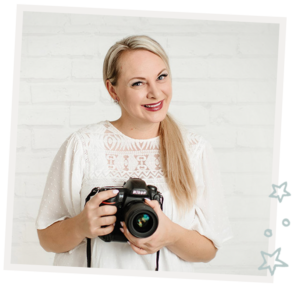
I'm
Lisa DiGeso
I’m on a mission to create uplifting online experiences for photographers ready to elevate their art, their business and their mindset.(...and have fun along the way!)

